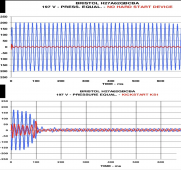Hedges
I See Electromagnetic Fields!
- Joined
- Mar 28, 2020
- Messages
- 20,814
I watched the link and know you have no reason to believe me. But if the run capacitor is increased 5X during start then the LRA peak instantaneous Amps will also increase by 5X. In your case your inverter must be able to handle the higher peak Amps for the shorter time period. A soft start lowers the LRA but iit does take longer to start.
You might keep in mind that your 100 msec meter is 7 cycles of 60 Hz so you are definitely missing the peak.
I don't think 5x cap will increase LRA 5x.
A simple capacitor across the AC line, yes current will be proportional to capacitance value.
But this is 5x increase in a capacitor that is in series with an inductor. Increase capacitance to infinity, and you just have the inductor directly across the line. 5x capacitor move impedance close to that of the inductor.
Similar to having two resistors in series. If you decrease one resistor value to 1/5 it's original value, the series resistance doesn't decrease as much.
There is probably some capacitor value which is optimum for maximum starting torque, providing something like 90 or 120 degree phase shift at 60 Hz with that particular winding inductance. Except, can't get more than 90 degree with one capacitor, and that would deliver zero power. The starting winding likely has a location some angle from the main winding, so one capacitor gives maximum starting torque and a different one maximum running torque.



